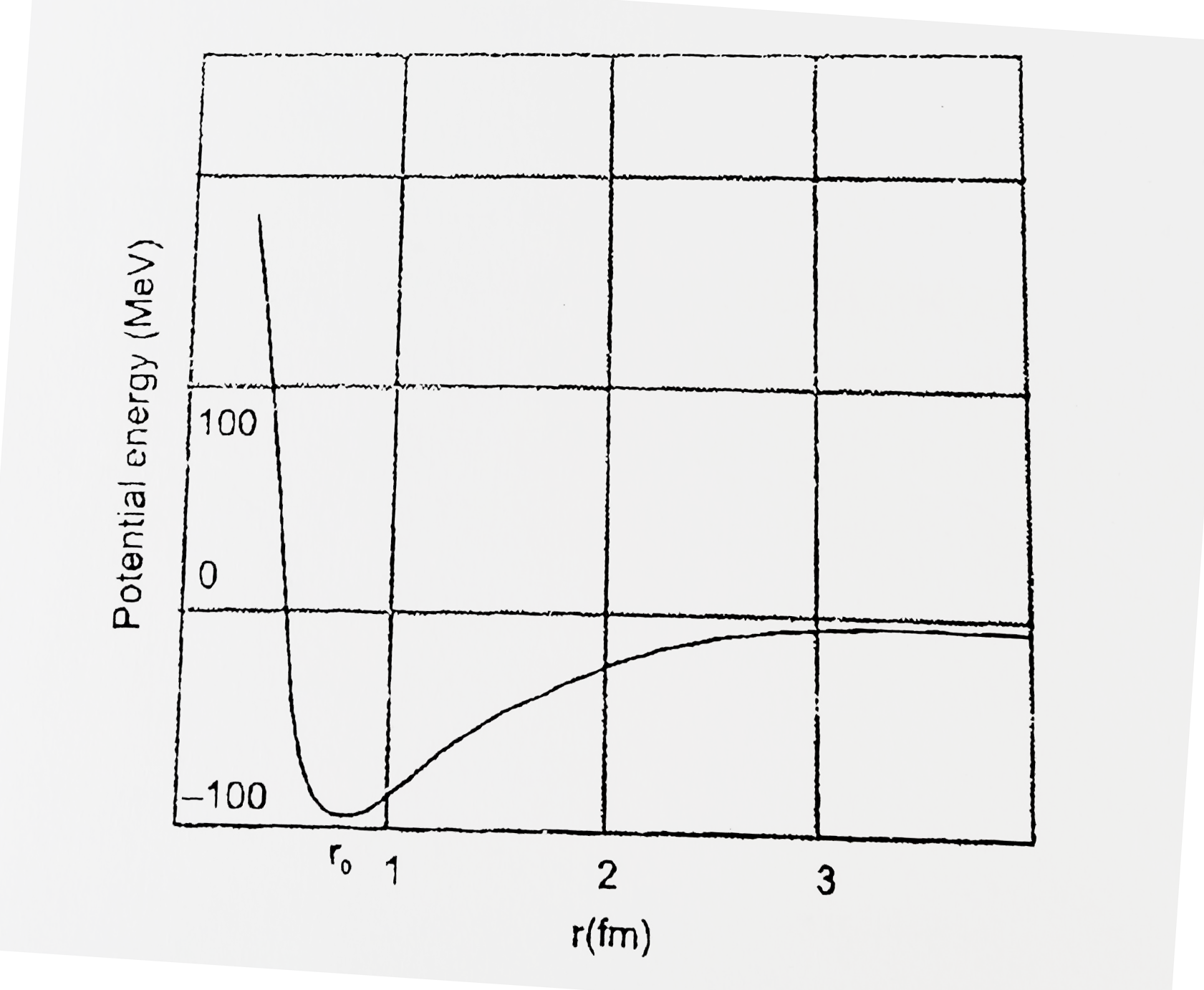Draw a plot of potential energy of a pair of nucleons as a function of their separation . Write two important conclusions which you can draw regarding the nature of nuclear forces .
Plot of potential of a pair of nucleons as a function of their separation is given in fig.

The potential is minimum at a distance r0(≈0.8fm). Following may be drawn from this graph:
(i) The nuclear force is much stronger than the Coulomb force acting between charges or the gravitational forces between masses.
(ii) The nuclear force between two nucleons falls rapidly to zero as theri ditance is mroe then a few femtometers.
(iii) For a separation greater than r0, the force is force is attractive and for separations less than r0 force is repulsive.
Topper's Solved these Questions
- NUCLEAR PHYSICSBook:RESONANCEChapter:NUCLEAR PHYSICSExercise:Advanced level solutions
Explore 16 Videos
- NUCLEAR PHYSICSBook:RESONANCEChapter:NUCLEAR PHYSICSExercise:Exercise-3 Part-II JEE (MAIN)
Explore 19 Videos
- GRAVITATIONBook:RESONANCEChapter:GRAVITATIONExercise:HIGH LEVEL PROBLEMS
Explore 16 Videos
- REVISION DPPBook:RESONANCEChapter:REVISION DPPExercise:All Questions
Explore 444 Videos
Similar Questions
(a) Draw the plot of binding energy per nucleon (BE/A) as a function of mass number A. Write two important conclusions that can be drawn regarding the nature of nuclear force.
(b) Use this graph to explain the release of energy in both the processes of nuclear fusion and fission.
(c) Write the basic nuclear process of neutron undergoing β-decay. Why is the detection of neutrinos found very difficult ?
View SolutionDraw a plot of potential energy of a pair of nucleons as a function of their separation. What is the significance of negative potential energy in the graph drawn ?
View SolutionDraw the plot of binding energy per nucleon as a function of mass number and write two important conclusion obtained from the graph.
View Solution(a) Draw a plot showing the variation of potential energy of a pair of nucleons as a function of their separation . Mark the regions where the nuclear force is :
(i) attractive and (ii) repulsive.
(b) In the nuclear reaction
n+235U→92aXe+54 94Sr+2nb determine the values of a and b .
View SolutionDraw a graph showing the variation of potential energy between a pair of nucleons as a function of their separation. Indicate the regions in which the nuclear force is (i) attractive, (ii) repulsive.
View Solution(a) Draw a plot showing the variation of potential energy of a pair of nucleons as a function of their separation . Mark the regions where the nuclear force is :
(i) attractive and (ii) repulsive.
(b) In the nuclear reaction
n+235U→92aXe+54 94Sr+2nb determine the values of a and b .
View Solution(a) Draw a plot showing the variation of potential energy of a pair of nucleons as a function of their separation. Mark the regions where the nuclear force is (i) attractive, and (ii) repulsive.
(b) In the nuclear reaction
n+ 23592U→ a54Xe+ 97bSr+2n determine the values of ‘a’ and ‘b’.
View SolutionDraw a graph between potential energy of a pair of nucleons and separation between them. Also write its main features.
View SolutionDraw a graph between potential energy of a pair of nucleons and separation between them. Also write its main features.
View Solution(a) In a nuclear reaction 32He+32He→42He+11H+11H+12.86 MeV, though the number of nucleons is conserved on both sides of the reaction, yet the energy is released. How? Explain.
(b) Draw a plot of potential energy between a pair of nucleons as a function of their separation. Mark the regions where potential energy is (i) positive and (ii) negative.
View Solution

